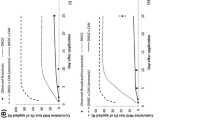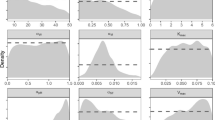Abstract
The use of emission factors (EF) for ammonia (NH3) after fertilizer application is a central tool for nitrogen management. Ammonia loss measurements after application of urea fertilizer at three research sites in Germany indicated that emissions deviated from European standard EFs. Scenario modelling of emissions based on long term weather data and variable application dates could provide a robust basis for the derivation of EFs. Two model approaches were used to test this approach for urea applied to winter wheat. The two model approaches comprised the dynamic model Volt’Air’ and a statistical model. Scenario calculations were run for 15 years and 4 application dates in each year for the 3 sites. The empirical model performed better at predicting cumulative losses. Both models simulated more than half of relative NH3 emissions (% urea N applied) in a range of 0–10%. The average and median EFs by both models over all application dates were 10.2 and 8.1%, respectively, and were substantially lower than the current European EFs for urea (15–16%). The lowest median and mean EFs were observed at beginning of the vegetation period with 4.3/4.8 and 7.2/6.7% applied N for empirical and Volt’Air model, respectively, and highest at wheat anthesis (15/17.4 and 11/10.2%). Scenario modelling can be considered as a tool for the derivation of robust and representative EFs for NH3 emissions not only for urea but also other emitting fertilizer sources. A much more expanded data set is needed and both model approaches require further development to reach this aim.









Similar content being viewed by others
Change history
12 October 2017
The captions of figures 3–6 in the original publication are misplaced. The correct figure captions are as follows.
References
Burnham KP, Anderson DR (2002) Model selection and multimodel inference: a practical information-theoretic approach, 2nd edn. Springer, New York, p 488
Demeyer P, Hofman G, Van Cleemput O (1995) Fitting ammonia volatilization dynamics with a logistic equation. Soil Sci Soc Am J 59:261–265
Denmead OT, Raupach MR (1993) Methods for measuring atmospheric gas transport in agricultural and forest systems. In: Harper LA et al (eds) Agricultural ecosystem effects on trace gases and global climate change. ASA special publication no. 55. ASA, Madison, pp 19–43
Dreccer MF, Schapendonk AHCM, Slafer GA, Rabbinge R (2000) Comparative response of wheat and oilseed rape to nitrogen supply: absorption and utilization efficiency of radiation and nitrogen during the reproductive stages determining yield. Plant Soil 220:189–205
EMEP/EEA (2016) EMEP/EEA Air pollutant emission inventory guidebook. Publications Office of the European Union, Luxembourg. doi:10.2800/247535, http://www.eea.europa.eu/publications/emep-eea-guidebook-2016
Freedman DA (1982) A note on screening regression equations. Am Stat 37(2):152–155
Galloway JN, Dentener FJ, Capone DG, Boyer EW, Howarth RW, Seitzinger SP, Asner GP, Cleveland CC, Green PA, Holland EA, Karl DM (2004) Nitrogen cycles: past, present, and future. Biogeochemistry 70:153–226
Genermont S, Cellier P (1997) A mechanistic model for estimating ammonia volatilization from slurry applied to bare soil. Agr For Meteorol 88(1–4):145–167
Gericke D, Pacholski A, Kage H (2011) Measurement of ammonia emissions in multi-plot field experiments. Biosyst Eng 108(2):164–173
Gericke D, Bornemann L, Kage H, Pacholski A (2012) Modelling ammonia losses after field application of biogas slurry in energy crop rotations. Water Air Soil Pollut 223:29–47
Haehnel K-D et al. (2016) Gaseous and particulate emissions from German agriculture 1990–2014 (RMD) Thünen Report 39, Johann Heinrich von Thuenen-Institut, Braunschweig, pp 412. doi:10.3220/REP145761729700
Kleemann M, Meliß M (1993) Regenerative energiequellen. Springer, Berlin, p 344
Kreuter T, Ni K, Gaßner M, Schmidhalter U, Döhler J, Pacholski A (2014) Ammonia loss rates from urea and calcium ammonium nitrate applied to winter wheat on three different sites in Germany. In: Marques dos Santos Cordovil CSC (ed) Proceedings of the 18th nitrogen workshop, Lisboa, Portugal, 30th June–3rd July 2014, pp 453–455
Le Cadre ES, Genermont S, Azam F, Recous S (2004) The SAHGA model to calculate the spatial ammoniacal heterogeneity at the soil surface after fertiliser granule application. Biol Fertil Soils 40(3):178–180
Michalczyk A, Kersebaum KC, Heimann L, Roelcke M, Sun QP, ChenXP Zhang FS (2016) Simulating in situ ammonia volatilization losses in the North China Plain using a dynamic soil-crop model. Nutr Cycl Agroecosyst 179(2):270. doi:10.1002/jpln.201400673
Monsi M, Saeki T (1953) Über den Lichtfaktor in den Pflanzengesellschaften und seine Bedeutung für die Stoffproduktion. Jpn J Bot 14:22–52
Müller C (2009) Dissertation. Institut für Pflanzenbau und Pflanzenzüchtung, CAU Kiel, p 2009
Nash JE, Sutcliffe JV (1970) River flow forecasting through conceptual models, Part I: a discussion of principles. J Hydrol 10:282–290
Ni K, Pacholski A, Kage H (2014) Ammonia volatilization after application of urea to winter wheat over 3 years affected by novel urease and nitrification inhibitors. Agric Ecosyst Environ 197:184–194
Ni K, Koester JR, Seidel A, Pacholski A (2016) Field measurement of ammonia emissions after nitrogen fertilization: a comparison between micrometeorological and chamber methods. Eur J Agron 71:115–122
Pacholski A (2003) Calibration of a simple method for determining ammonia volatilisation in the field-experiments in Henan Province, China, and modelling results. PhD-Thesis, Braunschweig Technical University. In: Landbauforschung Völkenrode–FAL Agricultural Research, Braunschweig, Germany. Special Issue 249, p 172
Pacholski A (2016) Calibrated passive sampling: multi-plot field measurements of NH3 emissions with a combination of dynamic tube method and passive samplers. J Vis Exp 109:e53273. doi:10.3791/53273
Pacholski A, Cai GX, Nieder R, Richter J, Zhu ZL, Roelcke M (2006) Calibration of a simple method for determining ammonia volatilization in the field: comparative measurements in Henan Province, China. Nutr Cycl Agroecosyst 74:259–273
Quakernack R, Pacholski A, Techow A, Herrmann A, Taube F, Kage H (2012) Ammonia volatilization and yield response after application of biogas residues to energy crops in a coastal marsh of Northern Germany. Agric Ecosyst Environ 160:66–74
Rachhpal-Singh Nye PH (1986a) A model of ammonia volatilisation from applied urea. 1. Development of the model. J Soil Sci 37:9–20
Rachhpal-Singh Nye PH (1986b) A model of ammonia volatilization from applied urea. II. Experimental testing. J Soil Sci 37:21–29
Sintermann J, Neftel A, Ammann C, Häni C, Hensen A, Loubet B, Flechard CR (2012) Are ammonia emissions from field-applied slurry substantially over-estimated in European emission inventories? Biogeosciences 9:1611–1632
Smith E, Gordon R, Bourque C, Campbell A, Genermont S, Rochette P, Mkhabela M (2009) Simulating ammonia loss from surface-applied manure. Can J Sil Sci 89(3):357–367
Sogaard HT, Sommer SG, Hutchings NJ, Huijsmans JFM, Bussink DW, Nicholson F (2002) Ammonia volatilization from field-applied animal slurry: the ALFAM model. Atmos Environ 36(20):3309
Sommer SG, Schjoerring JK, Denmead OT (2004) Ammonia emission from mineral fertilizers and fertilized crops. Adv Agron 82:557–622
Sprague LA, Oelsner GP, Argue DM (2017) Challenges with secondary use of multi-source water-quality data in the United States. Water Res 1(110):252–26130
Systat® 13 Statistics II (2009) SYSTAT Software Inc., Chicago, USA, p 502
Whaley J, Sparkes DL, Foulkes MJ, Spink JH, Semere T, Scott RK (2000) The physiological response of winter wheat to reductions in plant density. Ann Appl Biol 137:165–177
Willmott CJ (1982) Some comments on the evaluation of model performance. Bull Am Meteorol Soc 63(11):1309–1313
Willmott CJ, Matsuura K (2005) Advantages of the mean absolute error (MAE) over the root mean square error (RMSE) in assessing average model performance. Clim Res 30:79–82
Acknowledgements
The study was funded by SKW Piesteritz, Germany. We are grateful to Matthew Carabott for revision of use of English language.
Author information
Authors and Affiliations
Corresponding author
Additional information
The original version of this article was revised. The caption of figures 3–6 was misplaced. The correct figure captions is updated in the article.
A correction to this article is available online at https://doi.org/10.1007/s10705-017-9890-6.
Rights and permissions
About this article
Cite this article
Pacholski, A., Doehler, J., Schmidhalter, U. et al. Scenario modeling of ammonia emissions from surface applied urea under temperate conditions: application effects and model comparison. Nutr Cycl Agroecosyst 110, 177–193 (2018). https://doi.org/10.1007/s10705-017-9883-5
Received:
Accepted:
Published:
Issue Date:
DOI: https://doi.org/10.1007/s10705-017-9883-5




